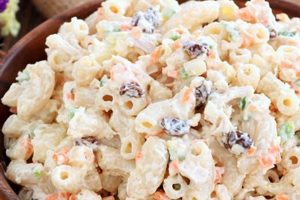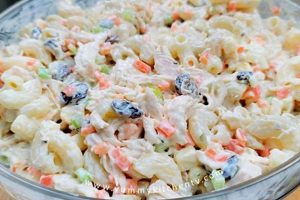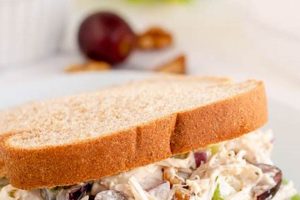Nutritious and flavorful variations on this classic dish typically involve lean poultry, a reduced-fat mayonnaise or alternative binder like Greek yogurt, and an assortment of fresh, wholesome ingredients such as fruits, vegetables, and nuts. An example might include grilled chicken breast, celery, grapes, and almonds dressed with a light vinaigrette.
Creating lighter versions offers significant advantages. These recipes can contribute to a balanced diet by providing lean protein, fiber, and essential vitamins and minerals. They can also be a lower-calorie and lower-fat option compared to traditional preparations. Over time, as dietary awareness has increased, innovations have led to a wider range of ingredients and preparation methods that prioritize health and well-being.
The following sections will delve into specific ingredient choices, preparation techniques, and creative serving suggestions for preparing delicious and healthful chicken salads.
Tips for Healthier Chicken Salad
Creating a nutritious and flavorful chicken salad involves careful ingredient selection and mindful preparation techniques. The following tips offer guidance for maximizing both taste and health benefits.
Tip 1: Prioritize lean protein. Opt for chicken breast or remove skin from other cuts to minimize fat content. Grilling, baking, or poaching are healthier cooking methods than frying.
Tip 2: Reimagine the binder. Instead of relying solely on mayonnaise, consider using Greek yogurt, avocado, or a combination of these for a creamier texture and added nutritional value. A small amount of light mayonnaise can still be incorporated for flavor.
Tip 3: Embrace fresh produce. Incorporate a variety of vegetables for added fiber, vitamins, and crunch. Celery, grapes, chopped apples, bell peppers, and red onion are excellent choices.
Tip 4: Boost flavor and nutrition with nuts and seeds. Almonds, walnuts, pecans, sunflower seeds, and pumpkin seeds provide healthy fats, protein, and textural complexity.
Tip 5: Enhance the flavor profile with herbs and spices. Fresh dill, parsley, chives, or tarragon can elevate the taste. A dash of curry powder, smoked paprika, or garlic powder can also add depth.
Tip 6: Control sodium content. Opt for low-sodium or no-salt-added ingredients when possible. Freshly ground black pepper and other herbs and spices can provide ample flavor without excess sodium.
Tip 7: Consider portion sizes. Even healthy variations should be consumed in moderation as part of a balanced diet.
By following these tips, one can create a chicken salad that is both delicious and supportive of health goals. These simple adjustments offer significant improvements in nutritional value without sacrificing flavor.
In conclusion, preparing a healthy chicken salad is a straightforward process with rewarding results.
1. Lean Protein Sources
Lean protein sources are fundamental to crafting chicken salad recipes that prioritize health and well-being. Protein plays a vital role in satiety, muscle maintenance, and overall metabolic function. Selecting lean protein options minimizes unhealthy fats and calories, contributing to a more nutritious meal.
- Chicken Breast:
Chicken breast is a classic choice for chicken salad due to its readily available lean protein. Removing the skin further reduces fat content. Poaching, grilling, baking, or boiling chicken breast are preferred cooking methods over frying to minimize added fats. Its mild flavor provides a versatile base for various flavor combinations.
- Turkey Breast:
Turkey breast offers a lean protein alternative to chicken. It possesses a slightly more distinct flavor profile than chicken, which can complement certain ingredient combinations, particularly those incorporating autumnal flavors like cranberries and walnuts.
- Canned Tuna (in water):
Canned tuna packed in water provides a convenient and affordable lean protein option. It offers a distinct flavor profile that pairs well with ingredients such as celery, onion, and dill. Draining the water thoroughly removes excess sodium.
- Plant-Based Alternatives:
For vegetarian or vegan adaptations, options like chickpeas or cooked lentils can serve as protein sources. These options offer different textures and flavor profiles, expanding the possibilities for creating innovative and plant-forward chicken salad alternatives. They also contribute valuable fiber and other nutrients.
The judicious selection of lean protein sources forms the foundation of any healthy chicken salad recipe. By prioritizing lean protein and employing appropriate cooking techniques, individuals can create a dish that contributes to a balanced and nutritious diet. This emphasis on lean protein not only enhances the healthfulness of the salad but also provides a versatile canvas for diverse flavors and textures.
2. Reduced-fat Mayonnaise
Reduced-fat mayonnaise plays a crucial role in creating healthier versions of classic chicken salad. Traditional mayonnaise, while contributing to creamy texture and flavor, is high in fat and calories. Substituting reduced-fat mayonnaise significantly lowers the overall fat content without drastically altering the desired texture. This substitution directly impacts the nutritional profile of the dish, aligning it with dietary goals focused on reduced fat and calorie intake. For example, using reduced-fat mayonnaise in a chicken salad featuring grilled chicken and plenty of vegetables creates a lighter, more nutritious meal compared to a version using full-fat mayonnaise. This simple swap contributes significantly to achieving a healthier outcome.
Furthermore, the use of reduced-fat mayonnaise allows for greater flexibility in incorporating other healthy ingredients. The lower fat content provides a foundation for adding nutrient-rich components such as avocado, nuts, or seeds without excessively increasing the overall fat content of the salad. This allows for the creation of complex flavor profiles and enhanced nutritional value while maintaining a health-conscious approach. For instance, a chicken salad featuring reduced-fat mayonnaise, chopped walnuts, and grapes offers a balance of healthy fats, protein, and antioxidants, contributing to a more wholesome meal. The lower-fat mayonnaise accommodates the inclusion of these beneficial ingredients without compromising the nutritional goals.
In summary, incorporating reduced-fat mayonnaise constitutes a practical and impactful strategy for creating healthier chicken salads. This substitution effectively lowers fat and calorie content while preserving desirable textural qualities. It also allows for the incorporation of additional healthy ingredients, resulting in a more nutritious and satisfying meal. Understanding the role of reduced-fat mayonnaise in creating healthier dishes contributes to informed dietary choices and facilitates the preparation of meals that support health and well-being.
3. Fresh Fruits and Vegetables
Fresh fruits and vegetables are essential components of healthy chicken salad recipes, contributing vital nutrients, vibrant flavors, and appealing textures. Their inclusion elevates the nutritional value while enhancing the overall sensory experience. Incorporating a variety of produce expands the culinary possibilities and promotes a balanced diet.
- Enhanced Nutritional Value
Fruits and vegetables are rich sources of vitamins, minerals, antioxidants, and dietary fiber. These nutrients contribute to overall health and well-being, supporting various bodily functions. For example, grapes provide antioxidants, while celery offers fiber, promoting digestive health and reducing cholesterol. In the context of chicken salad, these additions transform a simple protein source into a nutrient-dense meal.
- Flavor and Textural Diversity
The incorporation of fresh produce introduces a wide range of flavors and textures. Crisp vegetables like celery and bell peppers provide a satisfying crunch, while fruits such as grapes or apples offer sweetness and juiciness. These diverse elements create a more complex and enjoyable culinary experience, moving beyond the traditional limitations of chicken salad. Consider the contrast between the tartness of cranberries and the sweetness of chopped apples, both complementing the savory chicken base.
- Increased Volume and Reduced Calories
Adding fruits and vegetables increases the volume of the salad without significantly adding calories. This promotes satiety and helps manage portion sizes, contributing to weight management goals. For example, incorporating chopped cucumbers and bell peppers adds bulk and hydration without contributing significant calories, allowing for a larger, more satisfying serving.
- Culinary Versatility
The variety of available fruits and vegetables allows for endless customization and creativity in chicken salad recipes. Seasonal produce offers opportunities to experiment with different flavor profiles throughout the year. Consider a spring salad with fresh berries and spinach or an autumnal version featuring roasted butternut squash and dried cranberries. This adaptability ensures ongoing enjoyment and aligns the salad with seasonal availability.
The strategic inclusion of fresh fruits and vegetables transforms chicken salad from a basic dish into a vibrant and nutritious meal. By understanding the contributions of these ingredients from enhancing nutritional value and diversifying flavors to promoting satiety and offering culinary versatility individuals can create chicken salads that are both delicious and health-conscious. This approach emphasizes the integral role of fresh produce in crafting a well-rounded and satisfying culinary experience that supports overall well-being.
4. Wholesome Nuts and Seeds
Wholesome nuts and seeds represent valuable additions to health-conscious chicken salad recipes. These ingredients contribute essential nutrients, desirable textures, and nuanced flavors, elevating both the nutritional profile and the culinary experience. Their incorporation aligns with dietary trends emphasizing whole foods and plant-based nutrition.
- Nutritional Enrichment
Nuts and seeds offer a dense source of healthy fats, including monounsaturated and polyunsaturated fats, which contribute to cardiovascular health. They also provide essential minerals such as magnesium, zinc, and selenium, along with plant-based protein and fiber. For instance, almonds contribute vitamin E and magnesium, while walnuts are a good source of omega-3 fatty acids. These nutritional benefits enhance the overall healthfulness of chicken salad.
- Textural Enhancement
Nuts and seeds introduce satisfying textural contrasts to chicken salad. Their inclusion creates a more dynamic and engaging mouthfeel, moving beyond the typical smoothness of the dish. Sliced almonds offer a delicate crunch, while chopped walnuts provide a more robust texture. Sunflower seeds or pumpkin seeds contribute a unique, subtle crispness. These varied textures create a more complex and enjoyable culinary experience.
- Flavor Enhancement
The distinct flavors of various nuts and seeds complement the savory profile of chicken salad. Toasted pecans offer a rich, buttery flavor, while walnuts impart a slightly earthy note. Pine nuts contribute a delicate sweetness, while sunflower seeds provide a mild nuttiness. These diverse flavor profiles add depth and complexity to the dish, expanding beyond traditional flavor combinations.
- Portion Control and Satiety
The healthy fats, protein, and fiber content of nuts and seeds promote satiety, contributing to feelings of fullness and potentially aiding in portion control. These components contribute to a more satisfying meal experience, reducing the likelihood of overeating. This aspect aligns with health-conscious approaches to meal planning and weight management.
Incorporating wholesome nuts and seeds into chicken salad recipes offers multiple benefits. From enriching the nutritional value and enhancing textural and flavor complexity to promoting satiety, these additions contribute to a more health-conscious and enjoyable meal. Their inclusion exemplifies a shift toward whole-foods-based recipes that prioritize both health and flavor.
5. Herbs, Spices, and Seasonings
Herbs, spices, and seasonings play a crucial role in elevating healthy chicken salad recipes beyond basic preparations. Their strategic use enhances flavor complexity, reduces reliance on sodium, and introduces potential health benefits associated with specific botanicals. This multifaceted contribution aligns with culinary trends emphasizing fresh, flavorful, and health-conscious cuisine.
Flavor enhancement represents a primary advantage of incorporating herbs, spices, and seasonings. Fresh herbs like dill, parsley, chives, and tarragon introduce bright, aromatic notes that complement the subtle flavors of chicken and other ingredients. Spices such as paprika, cumin, and curry powder add depth and warmth, creating more complex flavor profiles. These additions reduce the need for excessive salt, aligning with dietary recommendations for sodium reduction. For example, a chicken salad featuring fresh dill, lemon zest, and black pepper offers a vibrant flavor profile without relying on high-sodium ingredients. Similarly, a curry-infused chicken salad with turmeric and ginger provides both flavor and potential anti-inflammatory benefits associated with these spices.
Beyond flavor, certain herbs and spices offer potential health benefits. Turmeric, known for its anti-inflammatory properties, can contribute to overall well-being when incorporated into the diet. Ginger, often used in Asian-inspired chicken salads, may offer digestive benefits. The inclusion of these ingredients aligns with the broader health-conscious approach of these recipes. Furthermore, the use of herbs, spices, and seasonings fosters culinary creativity, encouraging experimentation with diverse flavor combinations and ethnic influences. This exploration of flavor expands the culinary repertoire and reduces reliance on processed or high-sodium flavor enhancers. The versatility of these ingredients allows for customization based on personal preferences and dietary needs.
6. Portion Control
Portion control plays a critical role in the context of healthy chicken salad recipes. Even when using nutritious ingredients and mindful preparation methods, consuming excessive quantities can negate the health benefits. Calorie intake, regardless of nutritional density, contributes to weight gain if it exceeds energy expenditure. Portion control ensures that the consumption of chicken salad aligns with overall dietary goals. For example, a large serving of chicken salad, even if made with lean chicken and Greek yogurt, can contribute significantly to daily calorie intake. Conversely, a smaller portion of the same salad allows for balanced intake within a broader meal plan. This demonstrates the direct impact of portion control on the effectiveness of healthy chicken salad recipes in supporting weight management or maintenance goals.
Mindful portioning facilitates the inclusion of chicken salad within a balanced and varied diet. It allows individuals to enjoy the flavor and nutritional benefits of the dish without compromising dietary goals. Practical strategies include using smaller bowls or plates, pre-portioning individual servings, and paying attention to hunger and fullness cues. For example, pairing a modest serving of chicken salad with a side of mixed greens and a piece of fruit creates a balanced meal that provides a variety of nutrients and promotes satiety. This approach emphasizes the importance of integrating portion control into the overall dietary strategy, maximizing the health benefits of chicken salad while maintaining dietary balance.
Portion control is integral to maximizing the benefits of healthy chicken salad recipes. It ensures that the dish contributes to, rather than detracts from, health goals. By understanding the relationship between portion size and overall calorie intake, individuals can effectively incorporate chicken salad into a balanced and nutritious dietary pattern. This emphasizes the practical significance of portion awareness in realizing the full potential of healthy eating habits.
Frequently Asked Questions
This section addresses common inquiries regarding the preparation and consumption of healthy chicken salad.
Question 1: What is the best way to ensure chicken salad remains safe to eat?
Proper refrigeration is crucial. Chicken salad should be stored at or below 40F (4C) and consumed within 3-5 days. Maintaining appropriate temperature inhibits bacterial growth, ensuring food safety.
Question 2: Can frozen chicken be used for chicken salad?
While frozen chicken can be used, it should be thoroughly thawed before preparation. Thawing in the refrigerator is the safest method. Ensure complete thawing for even cooking and optimal texture in the final salad.
Question 3: How can sodium content be minimized in healthy chicken salad?
Opting for low-sodium or no-salt-added ingredients is essential. Fresh herbs, spices, and citrus juices can enhance flavor without relying on excess sodium. Draining canned ingredients thoroughly also reduces sodium content.
Question 4: What are suitable alternatives to mayonnaise in chicken salad?
Greek yogurt, avocado, or a combination of both offer healthier alternatives to mayonnaise, contributing creamy texture and additional nutrients. These alternatives reduce overall fat and calorie content.
Question 5: How can one adapt chicken salad recipes for specific dietary restrictions?
Substitutions can address various dietary needs. For gluten-free versions, ensure all ingredients, including seasonings and dressings, are gluten-free. Dairy-free options can utilize plant-based yogurt or avocado-based dressings. Ingredient lists should always be carefully reviewed.
Question 6: How can chicken salad be incorporated into a balanced meal?
Chicken salad can be served in various ways as part of a balanced meal. It can be enjoyed as a sandwich filling on whole-grain bread, served over a bed of mixed greens, or paired with fresh fruit or vegetables for a lighter option. Portion control is crucial for maintaining dietary balance.
Prioritizing food safety, mindful ingredient selection, and portion control are key takeaways for ensuring healthy and enjoyable chicken salad consumption.
The next section will explore specific recipe variations incorporating the principles discussed throughout this article.
Chicken Salad Healthy Recipes
Exploration of “chicken salad healthy recipes” reveals the significant impact of ingredient selection and preparation methods on nutritional value. Prioritizing lean protein sources, incorporating fresh produce, and utilizing reduced-fat alternatives to traditional mayonnaise demonstrably contribute to a healthier dietary profile. Furthermore, the strategic use of nuts, seeds, herbs, and spices enhances both flavor complexity and nutritional density. Portion control remains paramount, ensuring that even healthy variations align with overall dietary goals. These combined elements underscore the potential for transforming a classic dish into a nutrient-rich and health-conscious meal component.
The synthesis of culinary art and nutritional awareness empowers individuals to create meals that nourish both body and palate. Chicken salad, reimagined through the lens of health-conscious preparation, exemplifies this potential. Continued exploration of culinary techniques and ingredient combinations promises further innovation in healthy cuisine, contributing to a future where flavorful meals seamlessly integrate with well-being.






